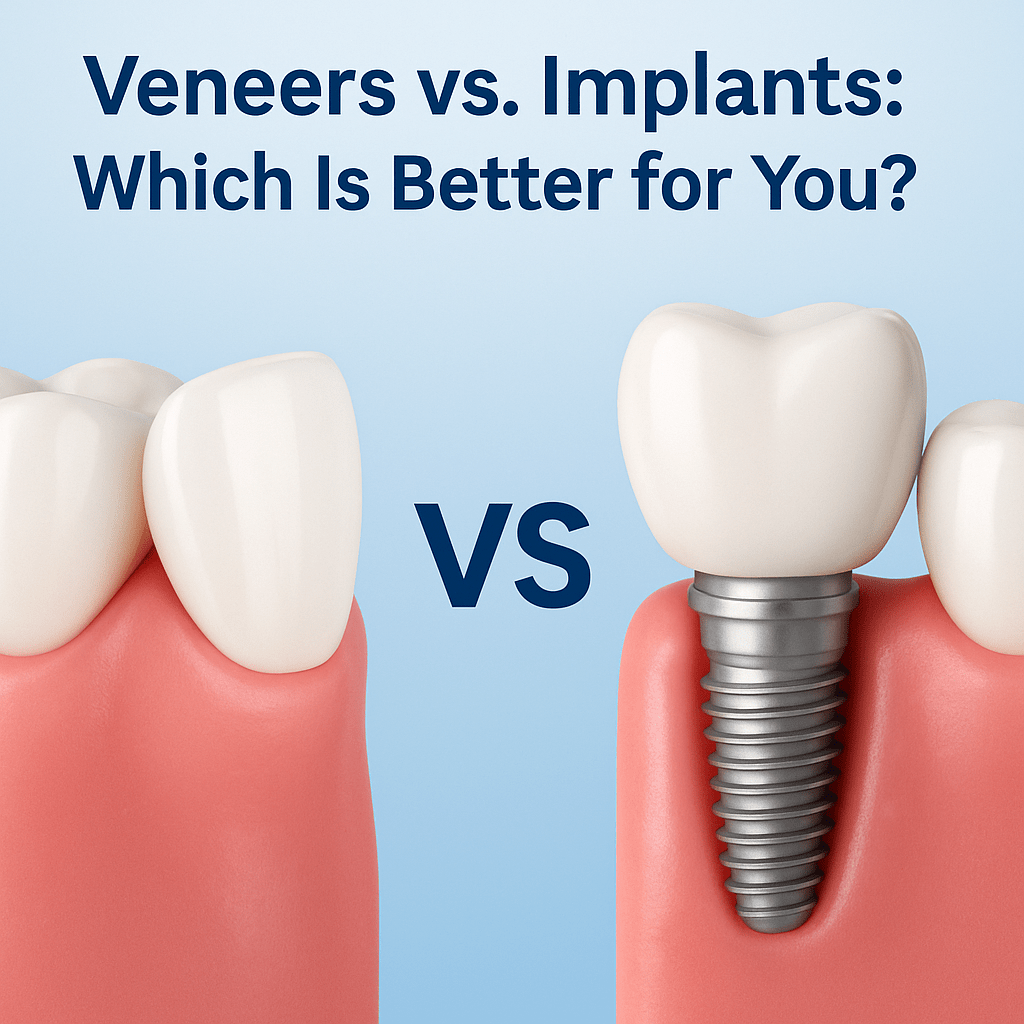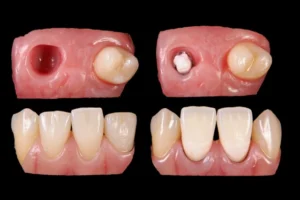Dental implants and dental veneers are often confused for one another. Nonetheless, they are different cosmetic dentistry procedures that can improve the aesthetics of teeth, gums, and smiles in monumental ways. Understanding dental implants vs veneers can help you choose the best option for your unique dental needs.
Table of Contents
ToggleDental Implants vs Veneers? Understanding the Key Differences
With advancements in dental technology, both Porcelain Veneers and Dental Implants have gained popularity in the past several decades — and now resin veneers are also a trusted option for achieving a natural, beautiful smile. There is still confusion about which one should be considered for restoration. If you’re wondering about dental veneers cost, it’s important to compare options and understand what fits your budget and dental goals best. Some patients ask, “Are implants better than veneers?” It depends on whether you need to replace a missing tooth or improve the look of an existing one. The debate of veneers vs dental implants comes down to your oral health and desired outcome. Understanding dental veneers vs implants helps patients make the right choice for long-term aesthetics and function.
Veneers Vs. Implants: Which Is Better for You?
With advancements in dental technology, both Porcelain Veneers and Dental Implants have gained popularity in the past several decades. There is still confusion about which one should be considered for restoration. If you’re wondering about dental veneers cost, it’s important to compare options and understand what fits your budget and dental goals best. . Porcelain veneers are used to enhance the appearance of the front surface of teeth. The treatment procedure for veneers typically takes a few visits. Initially, the teeth are examined, treatment options are suggested, and the dimension for veneers is marked on the teeth. This is followed by making an impression of the teeth and sending it to a dental lab. Provisional or temporary veneers may be fitted until the permanent ones are completed. Finally, after keeping the temporary veneers out, the permanent porcelain veneers are cemented onto the teeth (Begum Meer Rownaq Ali, 2023). Understanding the difference between veneers and implants is vital when choosing veneers vs implants. Many patients wonder whether veneers or implants suit them better, or if veneer implants are an option. Deciding on implants or veneers depends on your dental goals and bone health.
dental implants vs veneers : How to Choose the Right Treatment for
Dental veneers are very thin porcelain shells that cover the front of the teeth. There are many types of dental veneers: composite resin veneers, minimal preparation veneers (also known as ultrathin veneers or no-prep veneers), and porcelain veneers. All veneers apply to the treatment only in the visible area of the dentition; the chewing area is left untreated. In essence, the following treatment possibilities exist: Veneer before orthodontics: When the front teeth are not ideal in the shape/size and position, the orthodontist will always treat the teeth first, and once it’s perfect after orthodontics, the dental veneer will be done. Veneer/veneer after orthodontics: When the front teeth are ideal in position and overlapped but need only to change the shape of the teeth, the orthodontist may treat some bites, and the veneer will be done later. Comparing implants versus veneers, or veneers vs dentures, helps patients choose wisely. The veneer dental approach differs greatly from implants. Understanding veneers vs implants clarifies treatment options.
dental implants vs veneers : Pros and Cons to Consider
Dental implants are medical devices that are used to replace tooth roots. Implants provide a strong foundation for fixed (permanent) or removable replacement teeth that are made to match your natural teeth. Teeth implants provide several benefits including improved appearance, speech, comfort, and oral health. Tooth implants can last a lifetime when properly cared for. A dental implant is an artificial tooth root that is surgically placed in the jawbone. The implant fuses with the bone through a process called osseointegration, which takes time for the body to heal. Titanium is the most common dental implant material, a biocompatible metal that can fuse with the bone. Comparing dental implants vs veneers helps patients make an informed choice. Veneers dental procedures involve thin shells bonded to the front of teeth. Getting veneers on teeth is common for cosmetic fixes. Understanding veneers in dental care helps determine if they suit your aesthetic goals.

Are Dental Implants Stronger than Veneers?
In general, implants have a better prognosis than veneers, but each case must be assessed individually to understand the best option for the patient.
Successful treatment for both dental implants vs veneers requires a prosthetic and biological prognosis of more than 5 years; otherwise, it is deemed a failure.
Most studies indicate that implants have a higher survival rate than veneers, despite the reasons for failure shifting from biological issues to mechanical or fabrication-related problems.
The load-bearing capacity of minimally invasive direct and indirect veneers bonded to maxillary incisors with severe wear was tested to evaluate preparation design and material type (Ernst et al., 2018).
Loading began at 50 N and increased by 50 N every 5 cycles until fractures occurred; 14 out of 18 indirect inlays fractured between 900 and 1800 N.
Fracture strength values for veneers ranged from 667 ± 56 to 1369 ± 33 N but should be interpreted with caution due to a lack of distinction between direct and indirect veneers.
Veneers are typically produced chairside using direct methods or CAD/CAM technology.
Ideally, specimens manufactured according to ISO 6872 should be used for mechanical testing when comparing fracture strength for both approaches.
Comparisons were challenging because the lingual surfaces were inconsistently restored with veneers, crowns, or left untreated, making uniform testing difficult.
Chewing simulator tests scaled down to 5 Hz or stochastic chewing simulations are recommended, recording the number of cycles before fractures or loss of specimens.
This approach suggests life expectancy values for direct veneers (145 ± 17 days) that align closely with other studies where margins were properly finished and polished.
-
M Ionescu, AD Glodeanu, SM Popescu… – ISTORIE …, 2022 – istoriecraiova.ro. A brief history of dental implants. istoriecraiova.ro
Cited by 1M Miadili, X Li, Y Zhang, D Ruan, W Liu… – Frontiers in …, 2025 – frontiersin.org. The impact of jawbone regions (molar area, premolar area, anterior area) and bone density on the accuracy of robot-assisted dental implantation: a preliminary study. frontiersin.org
D Darvish, S Khorramymehr… – … Problems in Engineering, 2021 – Wiley Online Library. Finite element analysis of the effect of dental implants on jaw bone under mechanical and thermal loading conditions. wiley.com
Cited by 11NAOGL Abduvaliеv – Science and Education, 2023 – cyberleninka.ru. Benefits of using artificial bone in implantation. cyberleninka.ru
MA Ishneshah, AA Mohammad – المجلة الأفروآسيوية للبحث العلمي …, 2023 – aajsr.com. Dental Implant Materials and its Effect on the Alveolar Bone (Osseointegration) and Periodontal Tissues. aajsr.com
JC Kim, M Lee, ISL Yeo – Materials horizons, 2022 – pubs.rsc.org. Three interfaces of the dental implant system and their clinical effects on hard and soft tissues. rsc.org
Cited by 61SS Shukhratovich, JG Ziyadovich… – The American Journal of …, 2021 – inlibrary.uz. Dental Implantation And Its Classification. inlibrary.u


